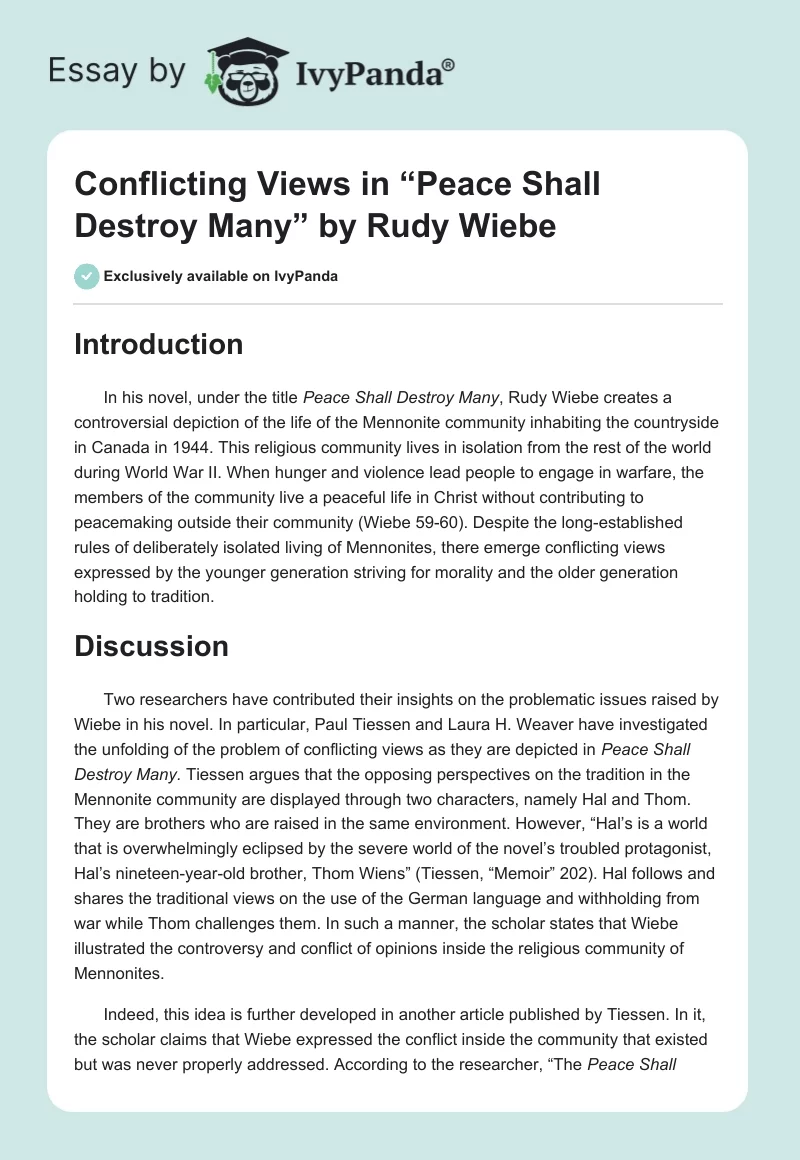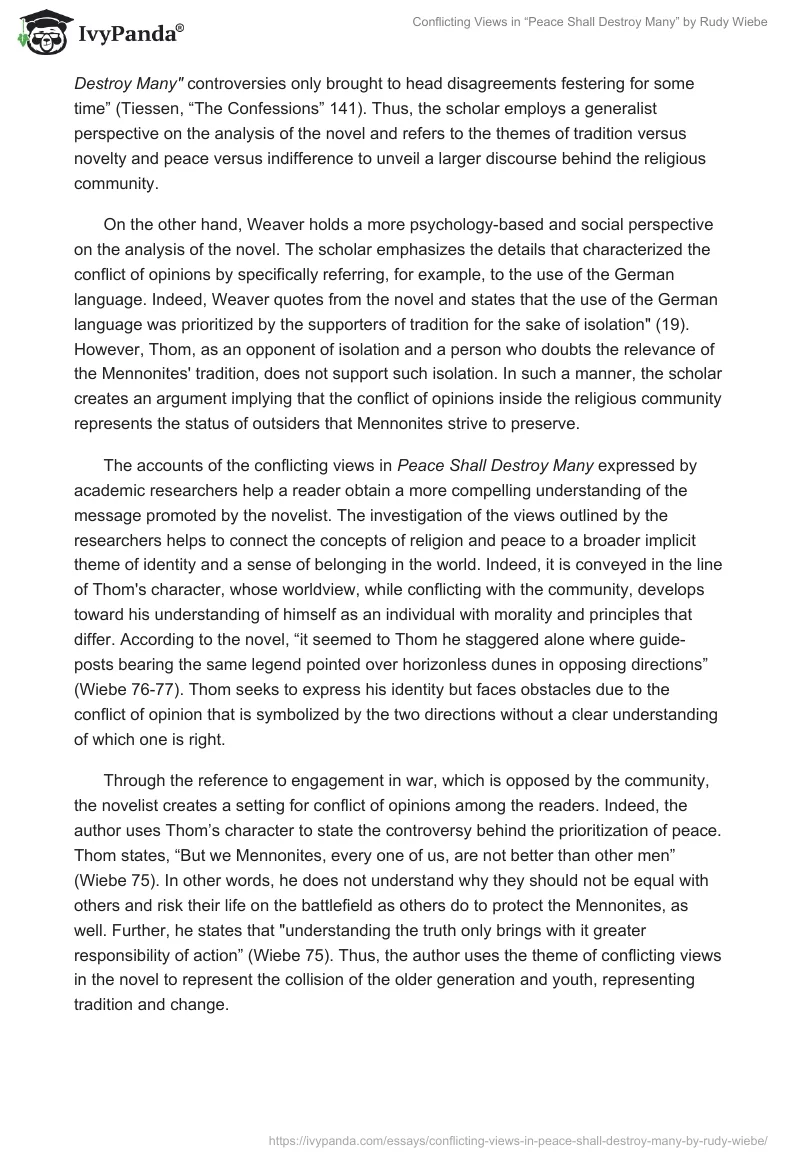Introduction
In his novel, under the title Peace Shall Destroy Many, Rudy Wiebe creates a controversial depiction of the life of the Mennonite community inhabiting the countryside in Canada in 1944. This religious community lives in isolation from the rest of the world during World War II. When hunger and violence lead people to engage in warfare, the members of the community live a peaceful life in Christ without contributing to peacemaking outside their community (Wiebe 59-60). Despite the long-established rules of deliberately isolated living of Mennonites, there emerge conflicting views expressed by the younger generation striving for morality and the older generation holding to tradition.
Discussion
Two researchers have contributed their insights on the problematic issues raised by Wiebe in his novel. In particular, Paul Tiessen and Laura H. Weaver have investigated the unfolding of the problem of conflicting views as they are depicted in Peace Shall Destroy Many. Tiessen argues that the opposing perspectives on the tradition in the Mennonite community are displayed through two characters, namely Hal and Thom. They are brothers who are raised in the same environment. However, “Hal’s is a world that is overwhelmingly eclipsed by the severe world of the novel’s troubled protagonist, Hal’s nineteen-year-old brother, Thom Wiens” (Tiessen, “Memoir” 202). Hal follows and shares the traditional views on the use of the German language and withholding from war while Thom challenges them. In such a manner, the scholar states that Wiebe illustrated the controversy and conflict of opinions inside the religious community of Mennonites.
Indeed, this idea is further developed in another article published by Tiessen. In it, the scholar claims that Wiebe expressed the conflict inside the community that existed but was never properly addressed. According to the researcher, “The Peace Shall Destroy Many” controversies only brought to head disagreements festering for some time” (Tiessen, “The Confessions” 141). Thus, the scholar employs a generalist perspective on the analysis of the novel and refers to the themes of tradition versus novelty and peace versus indifference to unveil a larger discourse behind the religious community.
On the other hand, Weaver holds a more psychology-based and social perspective on the analysis of the novel. The scholar emphasizes the details that characterized the conflict of opinions by specifically referring, for example, to the use of the German language. Indeed, Weaver quotes from the novel and states that the use of the German language was prioritized by the supporters of tradition for the sake of isolation” (19). However, Thom, as an opponent of isolation and a person who doubts the relevance of the Mennonites’ tradition, does not support such isolation. In such a manner, the scholar creates an argument implying that the conflict of opinions inside the religious community represents the status of outsiders that Mennonites strive to preserve.
The accounts of the conflicting views in Peace Shall Destroy Many expressed by academic researchers help a reader obtain a more compelling understanding of the message promoted by the novelist. The investigation of the views outlined by the researchers helps to connect the concepts of religion and peace to a broader implicit theme of identity and a sense of belonging in the world. Indeed, it is conveyed in the line of Thom’s character, whose worldview, while conflicting with the community, develops toward his understanding of himself as an individual with morality and principles that differ. According to the novel, “it seemed to Thom he staggered alone where guide-posts bearing the same legend pointed over horizonless dunes in opposing directions” (Wiebe 76-77). Thom seeks to express his identity but faces obstacles due to the conflict of opinion that is symbolized by the two directions without a clear understanding of which one is right.
Through the reference to engagement in war, which is opposed by the community, the novelist creates a setting for conflict of opinions among the readers. Indeed, the author uses Thom’s character to state the controversy behind the prioritization of peace. Thom states, “But we Mennonites, every one of us, are not better than other men” (Wiebe 75). In other words, he does not understand why they should not be equal with others and risk their life on the battlefield as others do to protect the Mennonites, as well. Further, he states that “understanding the truth only brings with it greater responsibility of action” (Wiebe 75). Thus, the author uses the theme of conflicting views in the novel to represent the collision of the older generation and youth, representing tradition and change.
Conclusion
In conclusion, the reading of the novel Peace Shall Destroy Many by Rudy Wiebe was an insightful academic experience. With the help of evidence obtained from the research literature, the reader found that the author’s goal in writing the book was to express the ambiguity of the concepts of peace and religion at the community and individual levels. Indeed, the controversy behind the opposing views of the characters in the book denotes the collision of the diversity of moral and worldview perspectives of the people in the world. The principles on which characters heavily rely emerge as elusive once taken into a broader perspective, such as the reasonability of maintaining peace by compromising morality.
Works Cited
Tiessen, Paul. “The Confessions of Rudy Wiebe: Re-positioning the Peace Shall Destroy Many Event of 1962–63.” Journal of Mennonite Studies, vol. 36, 2018, pp. 137-151.
—. “Memoir and the Re-reading of Fiction: Rudy Wiebe’s of This Earth and Peace Shall Destroy Many.” Text Matters: A Journal of Literature, Theory and Culture, vol. 1, 2011, pp. 201-215.
Weaver, Laura H. “Mennonites’ Minority Vision and the Outsider: Rudy Wiebe’s Peace Shall Destroy Many and The Blue Mountains of China.” MELUS, vol. 13, no. 3-4. 1986, pp. 15-26.
Wiebe, Rudy. Peace Shall Destroy Many. Vintage Canada, 2001.


